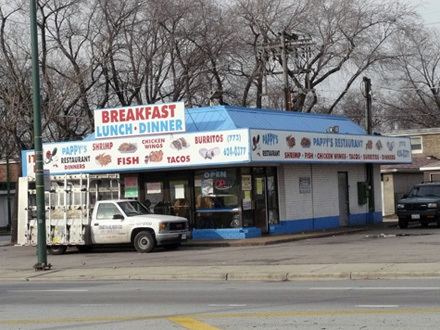Country United States Neighborhoods List- Area 184 ha Hispanic population 4.6% White population 1.6% | State Illinois Time zone CST (UTC-6) Asian population 0.2% Black population 92.2% Population 2,876 (2010) | |
 | ||
Restaurants No1 China Express, Good Food Organics, Wayne's BBQ & Cajun, Honey's To Go, I 94 Ribs & Grill | ||
Fuller Park, located on the south side of Chicago, Illinois, is one of 77 officially designated Chicago community areas. It is designated Community Area 37.
Contents
- Map of Fuller Park Chicago IL 60609 USA
- Geography
- History
- Crime poverty and other social problems
- Landmarks
- References
Map of Fuller Park, Chicago, IL 60609, USA
Fuller Park is named for the small park within the neighborhood, which is in turn named for Melville Weston Fuller, a Chicago attorney who was the Chief Justice of the United States between 1888 and 1910.
Geography
Fuller Park is one of Chicago's smallest community areas. It is a narrow two-mile strip of land, bounded by Pershing Road to the north; Garfield Boulevard to the south; the Dan Ryan Expressway and the Rock Island commuter line of Metra to the east; and the Chicago & Western Indiana Railroad to the west. Fuller Park lies due south of Guaranteed Rate Field (formerly U.S. Cellular Field), where the Chicago White Sox play. The neighborhood is five miles south of The Loop.
History
Fuller Park was originally part of the Town of Lake, until that town was annexed by the City of Chicago in 1889.
The neighborhood has always been a poor one. Many Irish Americans, many of whom worked for the railroads or stockyards, lived in Fuller Park before the American Civil War. In 1871, the Lake Shore & Michigan Southern Railroad built a railroad roundhouse in the area.
After the Great Chicago Fire, the City of Chicago adopted stronger building codes, and developers built beyond the city limits—including in the area now known as Fuller Park, which was then part of the Town of Lake. As a result, Fuller Park's population increased.
Several buildings in the neighborhood date back to this period, including 1870s frame houses located at 4463 South Wells and 4233 South Princeton. According to the Chicago Encyclopedia, "in the mid-1880s, Chicago architect Henry Newhouse designed and built a series of modest Queen Anne–style houses at 5029–5045 S. Princeton."
In the 1890s, German and Austrian immigrants moved to the neighborhood; African Americans began did the same after the turn of the century. By 1920, Irish and Germans immigrants had largely been replaced with African Americans, Mexicans, and Slavs.
As a result of the reformist Settlement movement, which began in the early 1900s and aimed to improve life in poor urban areas, Fuller Park opened in 1912. The park featured a Greek Revival fieldhouse, designed by Daniel H. Burnham and Company.
By 1950, one-quarter of the neighborhood's residents still lacked indoor toilets. Also in the 1950s, the Dan Ryan Expressway was built, splitting the neighborhood in two and displacing one-third of neighborhood's residents. The construction of Interstate Highway System also began to make the Union Stock Yards unnecessary; the yards declined in the 1960s and closed in 1971, eliminating many jobs.
Crime, poverty, and other social problems
Fuller Park is "one of the worst neighborhoods in the city by almost every metric." Fuller Park is the Chicago neighborhood which experienced the largest decline in population over the sixty years from the city's peak population in 1950 to 2010; its population declined precipitously from 17,000 in 1950 to under 3,000 in 2010, an 83 percent decline. In 2013, Fuller Park has the highest "hardship score" (a combined index of various social and economic statistics) among all Chicago neighborhoods. Fuller Park had the city's highest unemployment rate (40 percent), the second-highest percentage of households below the poverty line (55.5 percent), and the second-lowest per-capita income ($9,016). It was one of only two Chicago community areas with a per-capita income below $10,000. In late 2012, Fuller Park was also the only community area in which more than half the population was food-insecure. Fuller Park also rated the second-lowest in the city in trust in neighbors.
According to an analysis of 2012 city data on rates of specific violent crimes (homicide, assault, battery, sexual assault, arson, and burglary), Fuller Park was the most dangerous of Chicago's 77 community areas, with a crime rate of 13,456 per 100,000 people.
Landmarks
Fuller Park has the highest concentration of churches per 100,000 residents of any Chicago community area.
The community of Fuller Park is also home to Eden Place Nature Center, an environmental education and urban ecology center located on three acres in Fuller Park. Eden Place opened in 2003 through the efforts of community activists. The center was built on formerly blighted brownfield land. In 2012, 14,000 people visited Eden Place, about half of them schoolchildren. The center has received many accolades; First Lady Michelle Obama hailed it as a "success story," Illinois governor Pat Quinn honored its founder as an "environmental hero," and the center was featured in a PBS documentary on community environmental activities in large urban areas.
